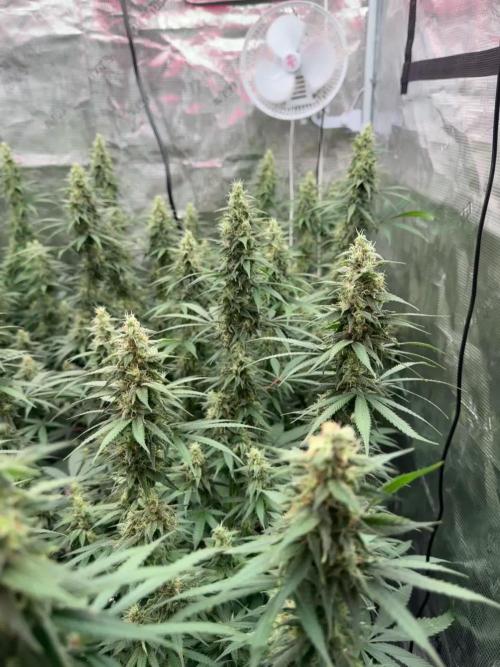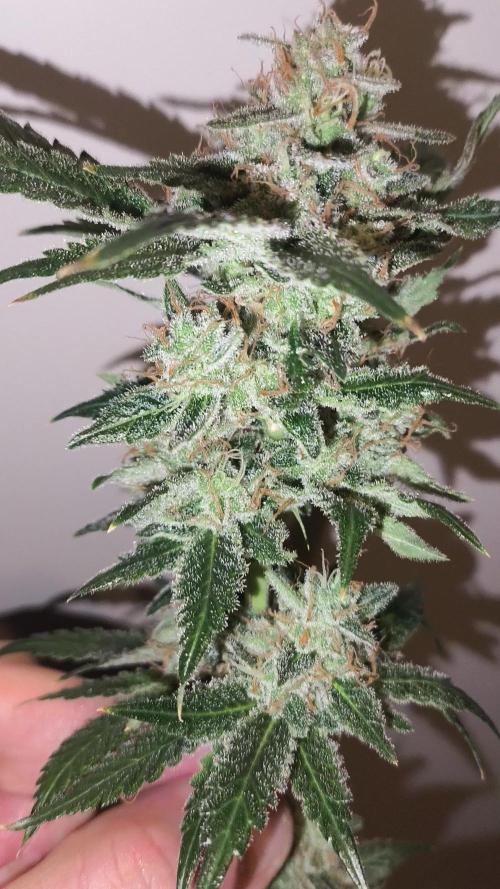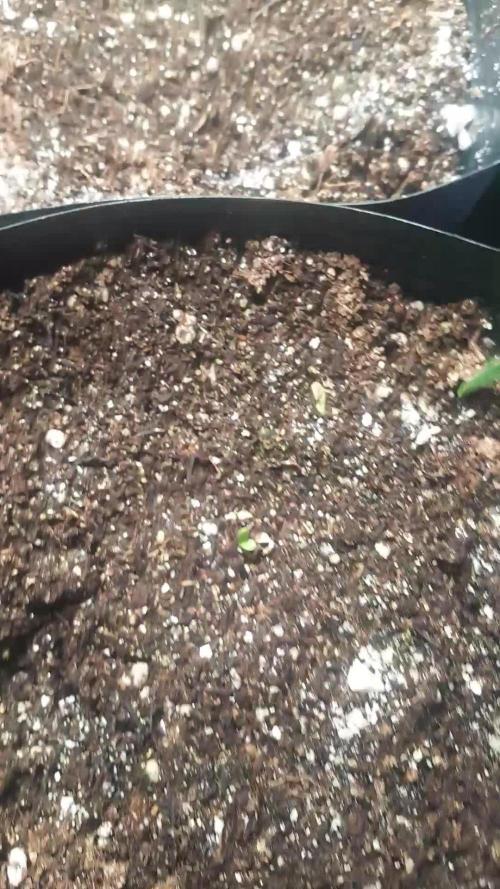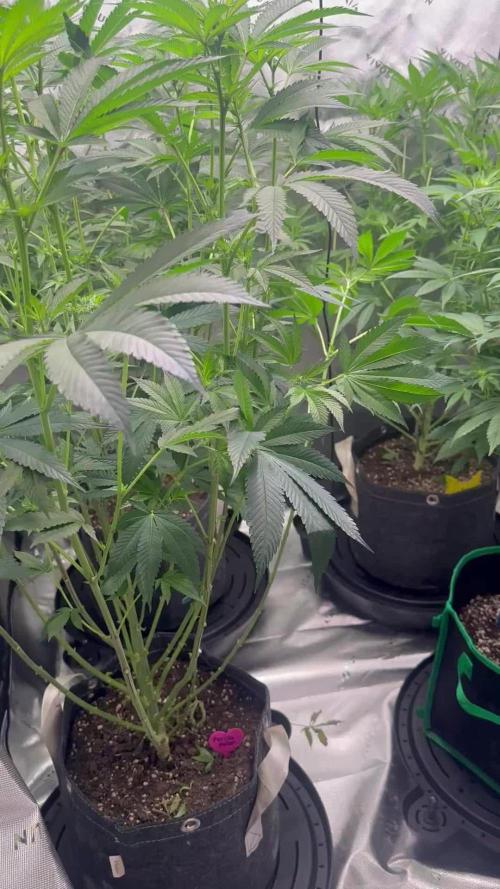The Grow Awards 2026 🏆 































Likes
Comments
Share


@Ultraviolet
Follow
A light spectrum in the scope of 400 to 700nm induces growth and development, and UV (100–400nm) and infrared (700–800nm) light play a role in plant morphogenesis—which is essentially the process of plants developing their physical form and external structure.
Optimizing Your Knowledge in the Grow Room
To maximize your yield, always aim for 40 moles, or 40,000,000 μmol, per day. Here is how much PPFD is needed per second for each phase of cannabis growth to achieve the DLI of 40 moles of light per day.
Seedling phase (18hr cycle): 200–300 μmol m-2 s-1
Vegetative phase (18hr cycle): 617 μmol m-2 s-1
Flowering phase (12hr cycle): 925 μmol m-2 s-1, (1500 μmol m-2 s-1 @2000ppm co2) (ballpark)
When choosing grow lights for cannabis, it is essential to check the technical specifications to determine if they are strong enough to get the job done. Of course, this doesn't mean that you have to buy the most expensive lights there are.
Still, it does mean that you should research each of these specifications in relation to your cannabis plants to find a grow light that will fully serve your needs. This is especially true with PPFD, as this is arguably the most insightful value for growers—it tells you exactly how much useful light your plants are absorbing at a certain distance from the grow light. With my fixed light source, as the plant develop height through stages, it will naturaslly grow into higher μmol ranges naturally dictated by its height. Look forward to filling the tent for the next grow.
Last week will see increased blues.
ELONGATED HYPOCOTYL5 (HY5), a bZIP-type transcription factor, acts as a master regulator that regulates various physiological and biological processes in plants such as photomorphogenesis, root growth, flavonoid biosynthesis and accumulation, nutrient acquisition, and response to abiotic stresses. HY5 is evolutionally conserved in function among various plant species. HY5 acts as a master regulator of a light-mediated transcriptional regulatory hub that directly or indirectly controls the transcription of approximately one-third of genes at the whole genome level. The transcription, protein abundance, and activity of HY5 are tightly modulated by a variety of factors through distinct regulatory mechanisms. This review primarily summarizes recent advances in HY5-mediated molecular and physiological processes and regulatory mechanisms on HY5 in the model plant Arabidopsis as well as in crops. Plants utilize light as the predominant energy source for photosynthesis. Besides, light signal acts as an essential external factor that mediates a variety of physiological and developmental processes in plants. Plants are continuously exposed to dynamically changing light signals due to the daily and seasonal alternation in natural conditions. The various light signals are perceived by at least five classes of wavelength-specific photoreceptors including phytochromes (phyA-phyE), cryptochromes (CRY1 and CRY2), phototropin (PHOT1 and PHOT2), F-box containing flavin binding proteins (ZTL, FKF1, and (LKP2), and UV-B RESISTANCE LOCUS 8 (UVR8). These photoreceptors are biologically activated by various light signals, subsequently initiating a large scale of transcriptional reprogramming at the whole genome level. Extensive genetic and biochemical studies have established that the ELONGATED HYPOCOTYL5 (HY5), a bZIP-type transcription factor, tightly controls the light-regulated transcriptional alternation. Loss of HY5 function mutant seedlings display drastically elongated hypocotyls in various light conditions, suggesting that HY5 acts downstream of multiple photoreceptors in promoting photomorphogenesis in plants. In addition to inhibiting hypocotyl growth, HY5 regulates other various physiological and developmental processes including root growth, pigment biosynthesis and accumulation, responses to various hormonal signals, and low and high temperatures. This review summarizes the recent advances and progress in HY5-regulated cellular, physiological, and developmental processes in various plant species. We also highlighted emerging insights regarding the HY5-mediated integration of multiple developmental, external, and internal signaling inputs in the regulation of plant growth.
Among the genes regulated by the circadian clock, we found that the excision repair protein XPA is controlled by the biological clock, and we, therefore, asked whether the entire nucleotide excision repair oscillates with daily periodicity. XPA transcription and protein levels are at a maximum at around 5 pm and at a minimum at around 5 am. Importantly, the entire excision repair activity shows the same pattern. This led to the prediction that mice would be more sensitive to UV light when exposed at 5 am (when repair is low), compared to 5 pm (when repair is high). We proceeded to test this prediction. We irradiated two groups of mice with UV at 5 am and 5 pm, respectively, and found that the group irradiated at 5 am exhibited a 4–5 fold higher incidence of invasive skin carcinoma than the group irradiated at 5 pm. Currently, we are investigating whether this rhythmicity of excision repair exists in humans.
Molecular mechanism of the mammalian circadian clock. CLOCK and BMAL1 are transcriptional activators, which form a CLOCK-BMAL1 heterodimer that binds to the E-box sequence (CACGTG) in the promoters of Cry and Per genes to activate their transcription. CRY and PER are transcriptional repressors, and after an appropriate time delay following protein synthesis and nuclear entry, they inhibit their own transcription, thus causing the rise and fall of CRY and PER levels with circa 24-hour periodicity (core clock). The core clock proteins also act on other genes that have E-boxes in their regulatory regions. As a consequence, about 30% of all genes are clock-controlled genes (CCG) in a given tissue and hence exhibit daily rhythmicity. Among these genes, the Xpa gene, which is essential for nucleotide excision repair, is also controlled by the clock.
Circadian control of excision repair and photocarcinogenesis in mice. The core circadian clock machinery controls the rhythmic expression of XPA, such that XPA RNA and protein levels are at a minimum at 5 am and at a maximum at 5 pm. The entire excision repair system, therefore, exhibits the same type of daily periodicity. As a consequence, when mice are irradiated with UVB at 5 am they develop invasive skin carcinoma at about 5-fold higher frequency compared to mice irradiated at 5 pm when repair is at its maximum. The mouse in the picture belongs to the 5 am group with multiple invasive skin carcinomas at the conclusion of the experiment.
Processing
Likes
18
Share


@wheedtobeus420
Follow
Day 63 and still going. My ph was off the hook at 8.5 out the tap. Which I’ve gotten handled now. I couldn’t figure out this situation fast enough but she’s bulking and happy. She’s a slow chugging lady but that’s okay. Large and in charge can win the race. It’s
Likes
11
Share


@Greenconcept
Follow
La biobimba è partita con la fioritura,si prospettano 2 mesi interessanti.
Likes
5
Share


@ibbzy
Follow
Jesus! Smells like pineapples and some sort of exotic juice. Amazing. Definitely coming from the purple afghani lineage side
They’re chugging along nicely, will switch to the 10/14 next week and see if that helps with the ripening phase.
Sticky as hell, just brushing against them will feel like glue on your skin. Sticky, frosty and stinky!
Likes
12
Share


@ItsCannaDog
Follow
Our little plants had such a big growth spurs, little but of a smell but not to bad, just defoliated a little so the middle and bottom gets more light. Just added nutrients and can't wait to see what they produce.
Likes
7
Share


@AustinRon
Follow
Week 8 - Bolt 2 (Flower Week 2)
SB4Q - BOG Sour Bubble (BOG Bubble BX2)
Sour Bubble - BOG Seeds
(BOG Bubble x BOG Bubble)
Harvest Window:
Early Harvest: 52 ± 5 Days (7.4 Flower Weeks) 8 - 18 March 2023
or
Late Harvest: 84 ± 5 Days in Flower (12 Week Flowering) 7 - 17 April 2023
Veg Week
Start of Week: [ 2023-02-08, BSBQ4 56:F:9:1]
End of Week:
[ 2023-02-14, SB4Q 62:F:9:7]
HeightWeekStart: [ 8.5, in]
HeightWeekEnd: [ 9.0, in] #Last Topping
GERMINATION: 2022-12-16T14:25:51-0600
Week’s Environment
TempAvgMaxMin: [ x, y, z, °F]
RHAvgMaxMin: [ x, y, z, %]
VPDAvgMaxMin: [ x, y, z, kPa]
LightDistance: [ 21.5, in]
LightDimmer: [ 50 + 2 ticks, %]
LightPPFD: [ 786, µmol/m2/s] # 2/3 the way to 1000 PPFD at the center ~r
ReservoirTemperature: [ 56.5, ±1.5, °F]
Fertigation
The Rooted Leaf Hydro Chart:
- [ Primer A, 8.6, ml, gal]
- [ Primer B, 8.6, ml, gal]
- [ Silica Skin, 4.3, ml, gal]
- EC: 2.5
13, 13, 6.5
pA, pB, Ss, Lush green
4.3, 4.3, 3.25, 3
7, 7, 3.5
Fertigation
The Rooted Leaf Hydro Chart:
- [ Primer A, 28, ml, 3 gal]
- [ Primer B, 28 ml, 3 gal]
- [ Silica Skin, 13, ml, 3 gal]
The Rooted Leaf Foliar Chart:
Monday:
Solar Rain: 20, ml, gal
Silica Skin: 20, ml, gal
Mammoth-P: [ 3, drops, pt]
Wednesday:
CalMag Fuel: 20, ml, gal
Lush Green: 5, ml, gal
Mammoth-P: [ 3, drops, pt]
Friday:
Solar Rain: 20, ml, gal
Mammoth-P: [ 3, drops, pt]
Peak Bloom: 5, ml, gal
___________________
Wed 08 February 2023
BSBQ4 56:F:9:1, 6:B:1:6
Thu 09 February 2023
BSBQ4 57:F:9:1, 7:B:1:7
Fri 10 February 2023
BSBQ4 57:F:9:1, 8:B:2:1
Sat 11 February 2023
BSBQ4 57:F:9:1, 9:B:2:2
Sun 12 February 2023
BSBQ4 57:F:9:1, 10:B:2:3

- Defoliated 3rd Node Fans, as they were hanging and blocking understory air flow
- Installed Copper Core Wire trainers to spread final 2 nodes of 4 meristems.
- Raised Lamp to LightDistance: [ 14.5, in]
- Adjusted dimmer to yield
- Center: [ 885, µmol/m2/s]
- Corners: [ 530, µmol/m2/s]


___________________
Mon 13 February 2023
BSBQ4 57:F:9:1, 11:B:2:4
Tue 14 February 2023
BSBQ4 57:F:9:1, 12:B:2:5
Likes
15
Share


@Professor_Daank
Follow
Google doc for nute schedule: https://docs.google.com/spreadsheets/d/1HtHnZOxMHtBK5DFQjpBun2lbhDxYVhI7lJaq4W6xbyk/edit?usp=sharing (Choose Sweet Seeds at the Bottom)
EC Target 1200-1500
Red Poison is getting the same treatment as everyone else, but showing curling tips. I'm almost positive this is genetics bc none of the other plants are showcasing any sort of issue - therefore, we move forward. GROW BABY!
Likes
20
Share


@Tmasm
Follow
Diário concurso zamnesia / Plagron
Agradeço, por prazer de criar mais uma genética zamnesia, e por poder experiência produtos Plagron.
Dia 14
2 das purple haze em papel toalha, em recipiente co tampa.
Dia 15
1 semente rebenta, deixa por mais um dia espera por semente 2
Dia 16
Semente 2 não abriu, parti carapaça com muito cuidado, apertado até abrir, deixei está passando 12h tem um ponta sair, deixar mais umas horas. Espro por dia 17 amanhã.
Semente 1 tudo correndo normal, coloquei em vaso final, agora tratá-la com máximo de carinho possível. 🤞😃
Plantas felizes
Não se esqueça de ver novidades em www.zamnesia.com
Crescendo em www.plagron.com
Likes
11
Share


@BudBeezy
Follow
Welcome to week 22 of my grow diary. It rained at the beginning of the week. On Monday and Tuesday I only left the plant outside for half a day and when it rained I put it in the garage so that the buds wouldn't get wet. Unfortunately, in this weather there is a high risk that the flowers will start to mould. Most of the trichomes are now milky.
See you next week ✌️
Likes
162
Share


@Lukush
Follow
1 week , hear we go , so excited of this strain, cant wait to see her beautifol buds structur 😎😎
Hope and im shoure yall enjoy
Have a good day growmies 🌲🌲✌️✌️
Likes
39
Share


@Theia
Follow
Well what can i say about this lady. Perfect girl. Super tall structure with great space for light penertration and airflow. Numerous budsites and good things hoped for.
No drama to report apart from her height being a bit of a concern.. But a bit of adjusting in the flower room and all is well.
Thanks for stopping by.
Please take care and grow well..💪👍
Likes
3
Share


@Liquido
Follow
Prima raccolta della mia vita, molto soddisfatto, dopo una settimana in flush ho deciso di tagliare in quanto i tricomi stavano diventando ambrati, dopo questo ciclo sicuramente ho capito l'importanza del Lollipoping e sicuramente al prossimo saprò come valutare la gestione
Processing
Likes
4
Share


@MallorcaBreeders
Follow
Ultima limpieza de bajos, y a florecer!! las plantas presentas 3 fenotipos, pero 3-4 características diferentes, algunas no ramifican apenas, algunas mucho y otras lo normal, Las de porte grande y robusto tienen un espacio entre nudos entre 6-7cm, pero sus ramas no cogen un vigor muy alto. luego hay otro fenotipo mas pequeño con espacios entre nudos de 4cm que si tienen gran vigor sus ramas. y otras que son como una mezcla entre las dos.
Likes
8
Share


@Kindbudz
Follow
This week has gone great! At the beginning of the week we flushed the remaining Fox farm nutrients we had been using before with Sledgehammer. After we treated with an organic compost tea brewed by our local hydroponic shop. We started with the Cyco Platinum Series this week. It’s still a bit early to tell but we will see how this nutrient line performs. I am very optimistic. As you may be able to tell I have a reservoir with coco coir mix on top with a drip irrigation system. I’m going to be trying out this system and an ebb and flow system in the upcoming weeks. I’m looking to maximize quality and quantity and believe these two system offer some of the best results. We look forward to starting that project! As for the lady she is looking extremely healthy. She is recovering well from being topped and lst. We’re going to let her grow up a bit now and stretch her out across the first trellis. My experience says this should be in 2-3 weeks and the. We will let her grow up through the second trellis. All in all I believe I’m looking at a 7-10 week veg. My goal is to shoot for a minimum of 1.3lbs from one plant. Thanks for taking the time to read this. Leave a comment if you have any questions or if you have any suggestions! Please check out my Instagram. Link in my Bio. Peace ✌️ Love ❤️ and Thanx 👍
Likes
6
Share


@Jardineiro_Br
Follow
Aproveitando a primavera para um cultivo rápido.
Dessa vez com sensações originais da Fast Buds.
Essa planta apresenta fenótipos com belos núcleos e tenho uma estratégia planejada para tentar ativar as anticioninas. Dia 31 de outubro foram para o papel umedecido, torcendo para 100% de germinação. 11/02 foram para os vasos. Dia 03 de novembro segue tudo bem parece.
Likes
3
Share


@Krautbauern
Follow
The calmag deficiency has improved significantly and the plants are now putting all their energy into the flowers.
In the meantime, no new eggs are forming, which makes us very happy :)


























